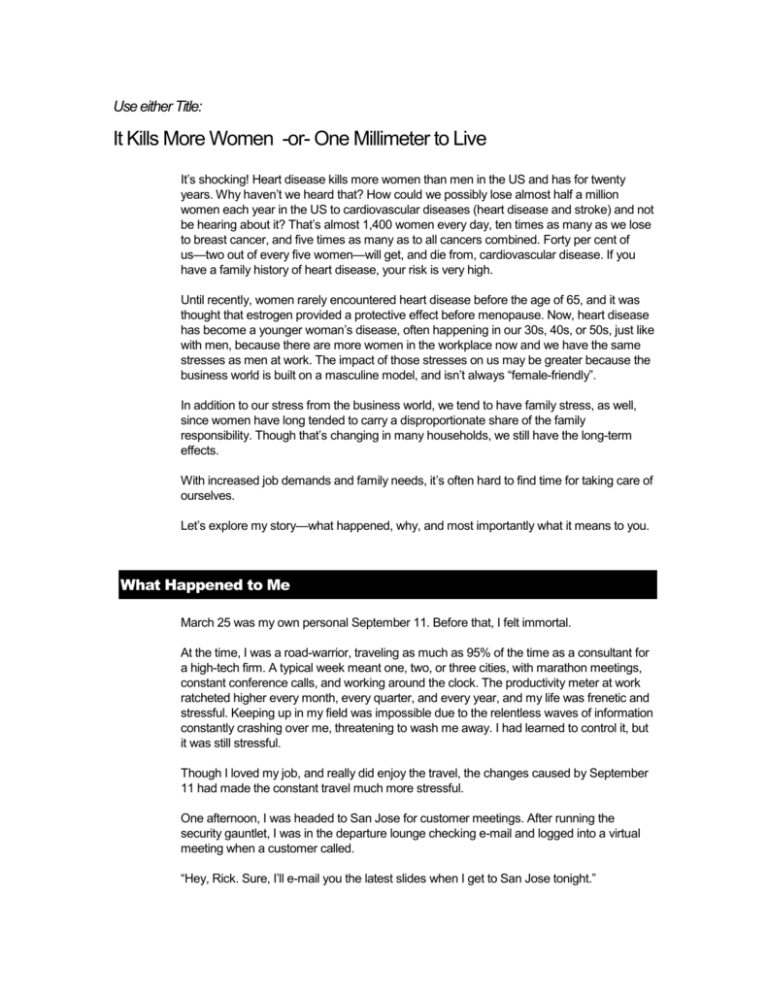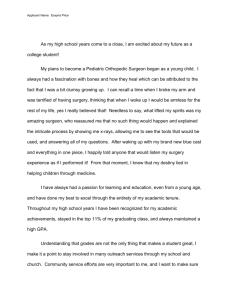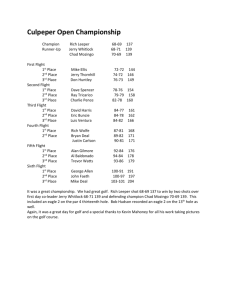
Use either Title:
It Kills More Women -or- One Millimeter to Live
It’s shocking! Heart disease kills more women than men in the US and has for twenty
years. Why haven’t we heard that? How could we possibly lose almost half a million
women each year in the US to cardiovascular diseases (heart disease and stroke) and not
be hearing about it? That’s almost 1,400 women every day, ten times as many as we lose
to breast cancer, and five times as many as to all cancers combined. Forty per cent of
us—two out of every five women—will get, and die from, cardiovascular disease. If you
have a family history of heart disease, your risk is very high.
Until recently, women rarely encountered heart disease before the age of 65, and it was
thought that estrogen provided a protective effect before menopause. Now, heart disease
has become a younger woman’s disease, often happening in our 30s, 40s, or 50s, just like
with men, because there are more women in the workplace now and we have the same
stresses as men at work. The impact of those stresses on us may be greater because the
business world is built on a masculine model, and isn’t always “female-friendly”.
In addition to our stress from the business world, we tend to have family stress, as well,
since women have long tended to carry a disproportionate share of the family
responsibility. Though that’s changing in many households, we still have the long-term
effects.
With increased job demands and family needs, it’s often hard to find time for taking care of
ourselves.
Let’s explore my story—what happened, why, and most importantly what it means to you.
What Happened to Me
March 25 was my own personal September 11. Before that, I felt immortal.
At the time, I was a road-warrior, traveling as much as 95% of the time as a consultant for
a high-tech firm. A typical week meant one, two, or three cities, with marathon meetings,
constant conference calls, and working around the clock. The productivity meter at work
ratcheted higher every month, every quarter, and every year, and my life was frenetic and
stressful. Keeping up in my field was impossible due to the relentless waves of information
constantly crashing over me, threatening to wash me away. I had learned to control it, but
it was still stressful.
Though I loved my job, and really did enjoy the travel, the changes caused by September
11 had made the constant travel much more stressful.
One afternoon, I was headed to San Jose for customer meetings. After running the
security gauntlet, I was in the departure lounge checking e-mail and logged into a virtual
meeting when a customer called.
“Hey, Rick. Sure, I’ll e-mail you the latest slides when I get to San Jose tonight.”
Just then, the gate agent, with her nasal voice, announced the flight. “Ladies and
gentlemen, flight 1733 is ready for boarding,” she said. “All Advantage Gold, Platinum, and
Executive Platinum passengers are welcome to board. If the other two of you will wait a
moment, we’ll call for you shortly.” Then she cringed as she stepped over to the door to
process the herd.
As regulars on that flight, everyone wanted to get on first to stash their stuff, so I wondered
if there would still be space in the overhead when I got on. Fortunately, there was, so I
hoisted my rollaboard into the overhead, put my computer bag under the seat in front of
me, and started pulling out my PC.
This American Airlines flight between Austin and San Jose is called the “Nerd Bird”
because it has more electronic gear per-capita than any other flight. We typical geek and
geekette road warriors carry a cell phone or two, a pager, a PDA, noise canceling
headphones, a DVD player, a laptop PC with wireless card, a power plug for the under
seat outlets, and of course enough cables to wire the terminal. The flight is so quiet—all
you hear is the tap, tap, tapping of keyboards.
Why do we techies carry all that gear? Well, you have to work the entire flight to keep up
with your job. Before we took off, I connected my PC to the wireless in the terminal and
downloaded the slides for my customer.
It was a good flight, and I got a lot of work done. I worked on several presentations and
meeting agendas, and also processed many of the hundreds of e-mails that had come in
while I was in meetings all day.
When we landed, I turned on my cell phone, pulled my rollaboard out of the overhead,
plunked my computer bag on top, and charged up the jetway. This time something was
different as it was harder to breathe. “Maybe it’s molds from the recent rains here in San
Jose,” I thought, since I’m very sensitive to molds.
I kept on going through the terminal, past security, down the escalators, and out to the
rental car shuttle, which had moved about two blocks farther down. As I slung my bags on
board, I could barely breathe and my left shoulder ached. I thought back to that USA
TODAY article I had just read containing new research that women have different heart
attack symptoms from men—where men have crushing chest pains, which they frequently
refer to as “the elephant on the chest,” and buckets of sweat, women’s symptoms are
more subtle.
If our symptoms are so subtle, how does a woman know that she’s having a heart attack?
She can have any, or all, of the four main symptoms: shortness of breath, tiredness (or
fatigue or sleeplessness), nausea, or pain in the left shoulder or arm (or jaw or shoulder
blade). I had two of those symptoms, so I arranged to see my doctor when I arrived back
in Austin, and monitored myself the rest of the trip.
I told my doctor that I had experienced shortness of breath, which I chalked up to molds,
but wondered if it could be related to my heart because I also had pain in my left shoulder.
She decided to do a chest X-ray and an EKG—the EKG was abnormal so she sent me
straight to the emergency room.
“Can I drive myself?”
“No,” she answered, “Can someone else drive you, or should I call you an ambulance?”
Fortunately, my husband was close by, and he took me to the emergency room. On the
way, my blood pressure spiked. It had been low at the doctor’s office, but I guess I was
just scared and panicky. Wouldn’t you have been, too?
At the emergency room, they took me straight to the Trauma Center and treated me for a
heart attack. There were half a dozen doctors and nurses running around, asking
questions, poking and prodding, and giving me nitroglycerin—it was enough to give you a
heart attack!
When the cardiologist arrived, his gentle demeanor put me at ease. He ordered chest Xrays, scans, and all kinds of tests, but didn’t find anything. He felt that it wasn’t a heart
attack, but did want to keep me all weekend for monitoring.
I was a reluctant patient. I had a lot of thoughts going on in my head. I didn’t want to be in
the hospital for the weekend—I needed to be home working on my taxes as it was almost
April 15 and with all my traveling I hadn’t had the time to do them. While I was in the
emergency room waiting to get checked into a room, I returned customer calls—I had
promised I would call them back after my doctor appointment. I wasn’t really worried about
what they would find in monitoring me—I’m too young for heart disease.
As you can tell, it hadn’t sunk in. I was totally in denial. I didn’t understand the significance.
Do you ever feel that way? Do you ever postpone taking care of your needs because
you’re so busy? We women tend to do that because we’re always taking care of everyone
else.
“I’ll go home and get your suitcase,” my husband said.
“You’ll need to unpack all of my business suits since I just got home, and please be sure to
bring my computer.”
When he got back without my computer, I was really annoyed. I had so much e-mail and
work to do that I just couldn’t get by without it. But he refused to bring it. What could I do? I
resigned myself to spending the weekend reading. At least he brought travel books so I
could focus on planning the trip to Rome and Florence. At least I could do something
useful, and not totally waste my time!
Can you relate to that? Never wanting to waste a minute? While a road warrior lifestyle is
stressful, being a Type A meant that some of my stress may have been self-inflicted.
Where did this Type-A behavior come from? I think mine was genetic. While I grew up, my
mother was a high-achiever who could never tolerate idle hands. Type-A behavior now
seems to run in our family. Does it run in your family, too?
All weekend they monitored me, and on Monday we were to meet with the cardiologist to
decide between a stress test and a heart catheterization. A stress test indicates heart
problems, but isn’t very reliable. A more reliable alternative is the heart catheterization.
Doesn’t that sound like fun? To do it, they cut open your leg, pump in some dye, and X-ray
you to look for blockage. A catheterization is 100% reliable, but is invasive. I didn’t want to
do it, and I sure didn’t want to be railroaded into it.
On Monday morning I couldn’t have coffee or food just in case I needed the
catheterization. I was groggy and walked up and down the hall to wake up. Suddenly, my
cardiologist zoomed in holding up a printout.
“What were you doing?” he asked, wide-eyed.
“Just walking,” I innocently answered.
“Well, you just had your stress test,” he said. “We’re doing that heart catheterization now.”
Larry, the orderly, wheeled me down. He was a hoot! He wore teal, yellow, and lavender
printed scrubs—quite a contrast to his flaming red hair. He cracked killer jokes. As he
wheeled me out the door, I asked “Is this a joke? Where are we going?”
“The mobile cath lab,” he said, as we bumped down the sidewalk and across the parking
lot, laughing and joking. Then he strapped the gurney into a window-washer platform, and
I’d swear I saw him hoist me up by pulling on ropes.
Once inside, Beth, my bartender, knocked me out and before I knew it we were done. I
came to as they wheeled me back into the hospital. They had found that a major coronary
artery was 95% blocked, and I was probably within hours of a heart attack. It was such a
relief to have escaped that!
The next day, they would send me to their sister hospital for a balloon angioplasty to open
the blockage and metal scaffolding, called a stent, to keep it open. It’s just routine, so there
was nothing to worry about.
I knew that I would miss some meetings, so that evening I set about making phone calls,
leaving voicemails, rescheduling meetings, and asking colleagues to cover for me, all the
while thinking that I would be back at work within a day or so and back to San Jose for
very important customer meetings early the next week. There was so much to be done
that I really couldn’t afford to be gone.
The next morning, the paramedics transported me to the other hospital. I remember them
asking me what I did, and when they found out that I was a road warrior with a high-tech
company, they started grilling me about how to set up Internet and wireless access and all
kinds of techie subjects. We laughed and joked the whole way, alleviating much of my
anxiety. Since they weren’t familiar with the route between the two hospitals, and I drove it
frequently, I pointed out landmarks and directed them to the hospital while lying down
strapped to the gurney. “You drive,” one of them jokingly suggested.
At the other hospital, the cardiovascular surgeon popped in to meet me. He was tall and
olive-skinned, with a strong accent and a very serious demeanor. My husband and I grilled
him extensively about the procedure, his experience, and anything else that was relevant
as I absolutely wasn’t going under until both my husband and I were confident about this.
He had lots of experience, and a great track record, so there was nothing to be concerned
about.
As they wheeled me into the operating suite, I chatted and laughed with the nurses until
the surgeon arrived. They gave me local anesthesia. I remember being awake through the
entire procedure, and watching it on the TV monitors above me. I kept hearing
seriousness in the surgeon’s voice, but couldn’t quite comprehend what it meant. He
seemed to be having difficulty. I heard him say, several times, “It’s too short. Get a longer
guide wire. We need one more millimeter.”
Even after removing the original guide wire, and replacing it with the longer one, he still
seemed to be having difficulty, but I couldn’t really tell what the problem was. When we
were done, I could see that he was pale and ashen gray and was hunched over.
After he left, the surgical team seemed to be having trouble stopping the bleeding, but
finally they succeeded in stopping it.
Once they got me back to my room, I noticed that the nurse kept coming in at what
seemed to be unusually frequent intervals. My blood pressure was dropping to
dangerously low levels, to the point where they had to call the surgeon that evening.
Fortunately, my husband recognized that I was dehydrated, probably from fasting and
surgeries two days in a row. Once I got some water, my blood pressure started to rise and
eventually returned to normal.
My husband seemed quite worried and upset, but I didn’t know why—it wasn’t until the
next morning that I learned of what the surgeon had told him.
The next morning, when the surgeon came in, he asked, “How are you doing this
morning?” There was no hint in his voice of the challenges the day before. “Yesterday was
difficult. Your blockage was at a juncture,” he said, as he drew a picture of it. “It was
close—putting the stent here at the blockage, in just one side of the juncture, would have
cut off blood flow to the other. You almost had a massive heart attack right there on the
operating table. It was close, but one millimeter made all the difference.” It was then that I
realized that even though he had performed over a thousand successful stent procedures,
he had nearly lost me.
“If you don’t make changes, your stent will need to be replaced, probably within three to
six months,” he continued, with his tone extremely serious. “After that close call, we can’t
do another angioplasty, so you’ll have open heart surgery.” That hit me hard and just
about knocked me flat.
“Let’s get you out of here. You can go back to work in a few days, but don’t travel for at
least two weeks.” With that, he reached over and pulled off one of my heart monitor leads
and said with a grin, “that’ll get a nurse in here quickly,” as he displayed his less-serious
side.
One millimeter made all the difference. One millimeter is barely visible to the eye, and yet,
it saved my life.
Why It Happened
What caused my heart disease? You can’t prevent it if you don’t know what causes it.
More importantly, how can you avoid it?
It’s odd. I really wasn’t a candidate for heart disease. I’m much too young—that’s an older
person’s disease, or so I thought. The reality is that you can be vulnerable at almost any
age.
There are four major risk factors: smoking, diabetes, high blood pressure, and high
cholesterol, which I didn’t have any of. In fact, my blood pressure and cholesterol were low
as I always ate healthfully, with mostly organic foods and no fried foods. Did I have family
history? At first, my doctors thought so, but have since discounted that, too.
It boiled down to my being overweight and over-stressed. Stress hijacks healthy habits,
and caused me to be overweight.
However, stress and overweight weren’t really the causes of my heart disease—they were
just symptoms. As I probed deeper, l realized that I was so busy with the craziness of my
road-warrior life that I hadn’t taken care of me. I thought I had, but there was so much
more I could have done. Now I have heart disease forever.
Excerpted from Chapters 1 and 2 of A Woman's Guide to Saving Her Own Life: The HEART Program
for Health and Longevity, by Mellanie True Hills. For more information see http://www.SaveHerLife.com
Mellanie True Hills, the Health & Productivity Revitalizer, is a women's health expert who speaks and
coaches individuals and organizations in creating healthy productivity. She is the author of A Woman's
Guide to Saving Her Own Life: The HEART Program for Health and Longevity and the CEO of the
American Foundation for Women's Health and the Atrial Fibrillation Patient Resource,
www.StopAfib.org. Find out more at http://www.mellaniehills.com and www.StopAfib.org.
Copyright 2005, 2006, 2007, 2008 by Mellanie True Hills. All rights reserved.







